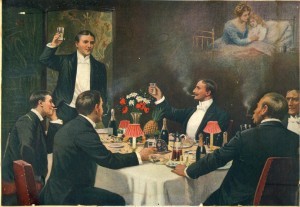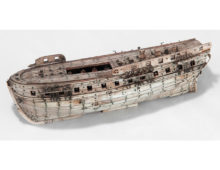Wars D’Oeuvre: How to re-enact the Battle of Waterloo at the dinner table
Reproduced from the magazine The Chap, by kind permission of Mr. Gustav Temple.
Chances are you’ll spend a large part of your summer at house parties in the Styx: where better to display your knowledge of the Battle of Waterloo (18th June 1815), which defined Europe for a hundred years, than in the dining hall of some centuried manorial dwelling.
Now it’s rather too much to hope that your host’s dinner table will boast the gently undulating landscape of central Belgium, and haring off to the WC for towels to jam under the linen will almost certainly upset the staff, and more importantly the port. Simply gesture sternly while informing your fellow guests that the table represents a shallow valley about two miles long, with ridges either side, along which the respective armies are deployed. If the moon-faced Johnny who simpers after your best girl happens to be on the French side, so much the better, but don’t rearrange the furniture to achieve this as it lessens the effect. Take this as an opportunity to comment significantly on the Iron Duke’s tactical use of reverse slopes.
Requisition the cruet set to represent La Haye Sante, a Belgian farmhouse; place it centrally, but towards the British lines. You will need something larger for the Chateau d’Hougoumont. Of course, excitable continentals dub anything larger than a potting shed a chateau, but in fairness Hougoumont was a more sizeable edifice. Use the bread basket, if there is one, it will be easier to set on fire. The chateau should be placed on the far right of the British line.
Napoleon launched his attack late in the morning with an artillery bombardment of Hougoumont. It is unwise to simulate this episode using flatware or leftovers, unless one is at one’s club, or an officers’ mess; in the former environs such behaviour is generally condoned; in the latter it is positively encouraged. The subsequent French infantry attack on the chateau should be illustrated by moving up bread rolls from the French left. Although Hougoumont was contested all day, you can’t be forever tinkering with your bread basket, so simply say so and have done. Lay heavy emphasis on the critical importance to Wellington of anchoring his right wing on Hougoumont to avoid being outflanked, and to protect his potential line of retreat to the sea. Say something like: “A lesson learned the hard way by Moore at Corunna” with enormous confidence and a wry smile.
If Napoleon’s intention was to force the Duke of Wellington to move reserves to his right wing, thus weakening his centre in anticipation of a French frontal assault, it didn’t work. Roll napkin rings across from the middle of your French line, past the cruet set, but have them beaten off by redcoat cutlery. Disarray the salt and pepper to indicate the continuing struggle for La Haye Sainte.
A signature moment has arrived: the counter-attacking charge of the British Household and Union Heavy Cavalry Brigades. This manoeuvre requires drama and panache, so rush filled red wine glasses across the table, past the ruins of the cruet set, into the French lines. Make sure to tip a couple over on the left to illustrate how the Scots Greys in particular, deaf to recall, while winning French eagles and disabling French guns, took very heavy casualties. Claret soaking into pristine white linen is a vivid and powerful metaphor, though it will probably make the butler blanche.
Now for the French cavalry charge. Use wine glasses again for consistency, but white wine for clarity, or even champagne flutes. Your object here is to demonstrate how the French, under Marshal Ney, misinterpreting a British manoeuvre as retreat, launched successive waves of cavalry against the impenetrable British infantry squares. Judge your audience, but the best way is probably to fling the champagne flutes at something hard, dining chairs, for example, or the fender from the fireplace, or indeed the butler. While everyone’s attention is diverted, use a candelabrum to ignite the breadbasket.
By now your fellow guests will be on the edge of their seats with excitement, or possibly under the table ducking glassware, choked with emotion and smoke. No matter: it is time for a little theatricality. If you have a special pal at the gathering, prearrange with him to do the honours; or have a word with your host, particularly if he’s moustachioed, ex-military and your best girl’s papa. From the eastern end of the battlefield, that is from the far left of the British line, at the height of the flute-flinging have your patsy sepulchrally intone: “The Prussians have arrived!” If cook has supplied an enormous Wurst to slap on the table at the correct juncture, so much the better. Napoleon has no choice but to send some of his napkin rings to deal with Blucher’s belated but battle-winning Wurst. By the time the Emperor is ready to send the Imperial Guard (use the gravy boat) to attack Wellington’s centre (cutlery again) in one last desperate move, despite the fall of La Haye Sainte, it’s too late. The British line infantry have rallied. For the first time in their history, the Guard are beaten back and retreat. Hurl the gravy boat at the dado on the far side of the room.
Step back and survey the scene. Smoke from the bread basket drifts lazily over the ruins of the cruet, shards of broken glass and crockery litter the gravy-spattered, claret-soaked cloth. Here and there, scowling, feral footmen salvage what they can from the chaos. Grim should be your aspect as you fix each of your fellow diners with a gimlet stare, which you may soften as it meets the admiring gaze of your best girl. Allow a single tear to course down your left cheek. Under your breath, but audibly, say: “Next to a battle lost, the greatest misery is a battle won.” Invite the ladies to withdraw.




